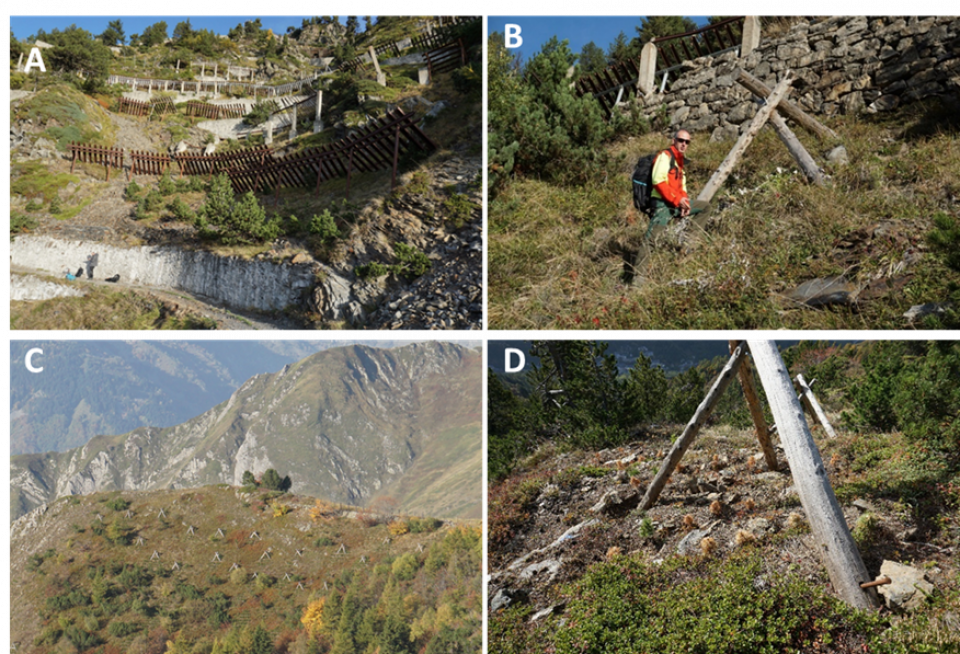
The village of Barèges, an important tourist destination, has been hit by snow avalanches from the mountainside to the north of the village several times. The village, which is part of the Grand Tourmalet ski destination, was evacuated because of avalanche hazards as late as 2013 and 2015. There are several avalanche paths on the valley side, and a number of existing measures exist in the form of fences, stone- and concrete barriers, and other structures, some as old as the 19th century. These do function, but in extreme winters, the existing fences are buried in snow, and avalanches can be released from the snowpack above the fences. In addition, they require extensive maintenance, which must be carried out on foot and is, therefore, very laborious.
The hazard at the Capet Forest site is from snow avalanches along the 'Midaou' avalanche path.
Through the H2020 project PHUSICOS afforestation by planted trees of 9 different species have been implemented. The trees will eventually grow high enough and develop a stem thickness to act as effective protection against avalanche release in ca. 20-30 years.
The implemented NbS intervention consists of afforestation by planted trees of 9 different species (Pinus uncinata, Larix decidua, Abies concolor, Picea engelmanii, Pinus cembra, Pinus ponderosa, Pinus bougetii, Pinus sylvestris, Cedrus deodora) all of which are considered to be adapted to the climate and elevation (1800-2200 m asl.) of the site.
The plants are either protected by the 88 newly built wooden tripods, by the existing grey structures, or by existing natural groups of trees. The plants are planted in polygons downslope of the protective structure. In total there are 257 polygons, 189 big polygons with 30 plants in each and 68 small polygons with 16 plants in each, totalling about 6758 trees, which were planted over a period of 4 years with the same age of plants in each polygon. A certain loss of plants is expected and even required since the plants in each collection (polygon) are planted too dense for the significant growth of all. The wooden tripods are also meant to serve as protection structures against avalanche release during their existence and until the planted trees grow high enough and develop a stem thickness to act as effective protection against avalanche release in ca. 20-30 years.
Success of the implemented interventions in the Capet Forest will only be evident in 20- 30 years but would then add to the growing acknowledgement of such sustainable solutions.
- less costly maintenance operations
- less human pressure and probably economic savings
- environmental benefits through less need for helicopters to lift heavy material for maintenance – this is also of benefit for wildlife in the forest (it also helps preserve several of the species and biotopes in this high-elevation forest)
- increased sense of safety among the villagers, both regarding the village itself, but also regarding road closures, etc.
- less avalanche threat is vital for tourism in the area, which is essential (alpine skiing, health baths, etc.)
- great upscaling potential
- Developing climate change mitigation
- Increase Biodiversity
- Increase well-being
This combination of grey infrastructure and plantation has a great replicability potential in areas exposed to avalanches. Indeed, the life span of grey infrastructure is extended by planting trees.
There are numerous avalanche prone areas where the release zones are barren or contain sparse forest cover only, and which therefore have a potential for afforestation as a mitigation measure.
- Challenges for the implementations encountered in the Pyrenees are mainly bureaucratic and related to the procurement process as well as to obtain necessary permissions to do the work. For the Capet site, local interest and enthusiasm were important enablers and ensured fast initiation of the work.
- The experience with the NbS installations is that some of the tripods were damaged by snow creep and had to be repaired.
- The 'survival rate' seems to vary with soil thickness, but other factors such as local topography and exposition may also influence the growth.
- Afforestation
- wooden tripods
